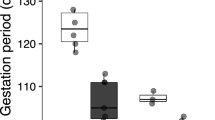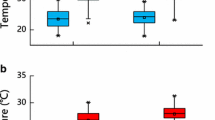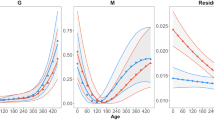Abstract
Temperature variability is predicted to increase in the coming century due to climate change. However, the biological impact of increased temperature variability on animals remains largely unexplored. Here, we experimentally exposed gravid viviparous lizards (Eremias multiocellata) to two thermal environments [constant daily maximum (CDM) versus variable daily maximum (VDM) treatment with the same average temperature] to address maternal and offspring responses to increased variability in ambient temperature. Females from the VDM treatment delayed parturition, but produced similar litter sizes and litter masses as did CDM females. Offspring from the VDM treatment selected higher body temperatures, had higher metabolic rates and higher growth rates, and grew to a similar size as those from the CDM treatment despite having a shorter growth period prior to hibernation. Therefore, phenotypic plasticity may be critical for lizards to respond effectively to climate change, and its role in responding to increasingly variable temperatures warrants further attention.




Similar content being viewed by others
References
Angilletta MJ (2009) Thermal adaptation: a theoretical and empirical synthesis. Oxford University Press, Oxford
Angilletta MJ, Winters RS, Dunham AE (2000) Thermal effects on the energetics of lizard embryos: implications for hatchling phenotypes. Ecology 81:2957–2968
Barange M et al (2014) Impacts of climate change on marine ecosystem production in societies dependent on fisheries. Nat Clim Chang 4:211–216
Basson CH, Clusella-Trullas S (2015) The behavior-physiology nexus: behavioral and physiological compensation are relied on to different extents between seasons. Physiol Biochem Zool 88:384–394
Bauerfeind SS, Fischer K (2014) Simulating climate change: temperature extremes but not means diminish performance in a widespread butterfly. Popul Ecol 56:239–250
Birchard GF, Reiber CL (1995) Growth, metabolism, and chorioallantoic vascular density of developing snapping turtles (Chelydra serpentina): influence of temperature. Physiol Zool 68:799–811
Brown JH, Gillooly JF, Allen AP, Savage VM, West GB (2004) Toward a metabolic theory of ecology. Ecology 85:1771–1789
Cadby CD, Jones SM, Wapstra E (2014) Geographical differences in maternal basking behaviour and offspring growth rate in a climatically widespread viviparous reptile. J Exp Biol 217:1175–1179
Charmantier A, McCleery RH, Cole LR, Perrins C, Kruuk LEB, Sheldon BC (2008) Adaptive phenotypic plasticity in response to climate change in a wild bird population. Science 320:800–803
Clarke DN, Zani PA (2012) Effects of night-time warming on temperate ectotherm reproduction: potential fitness benefits of climate change for side-blotched lizards. J Exp Biol 215:1117–1127
Clusella-Trullas S, Blackburn TM, Chown SL (2011) Climatic predictors of temperature performance curve parameters in ectotherms imply complex responses to climate change. Am Nat 177:738–751
Clutton-Brock TH (1991) The evolution of parental care. Princeton University Press, Princeton
Crill WD, Huey RB, Gilchrist GW (1996) Within-and between-generation effects of temperature on the morphology and physiology of Drosophila melanogaster. Evolution 50:1205–1218
Custer LM, Snyder MJ, Flegel K, Csankovszki G (2014) The onset of C. elegans dosage compensation is linked to the loss of developmental plasticity. Dev Biol 385:279–290
Deeming DC (2004) Reptilian incubation: environment, evolution and behaviour. Nottingham University Press, Nottingham
Del Monte-Luna P, Guzman-Hernandez V, Cuevas EA, Arreguin-Sanchez F, Lluch-Belda D (2012) Effect of North Atlantic climate variability on hawksbill turtles in the Southern Gulf of Mexico. J Exp Mar Biol Ecol 412:103–109
Deutsch CA et al (2008) Impacts of climate warming on terrestrial ectotherms across latitude. Proc Natl Acad Sci USA 105:6668–6672
Du WG (2006) Phenotypic plasticity in reproductive traits induced by food availability in a lacertid lizard, Takydromus septentrionalis. Oikos 112:363–369
Du WG, Shine R (2015) The behavioural and physiological strategies of bird and reptile embryos in response to unpredictable variation in nest temperature. Biol Rev 90:19–30
Du WG, Yan SJ, Ji X (2000) Selected body temperature, thermal tolerance and thermal dependence of food assimilation and locomotor performance in adult blue-tailed skinks, Eumeces elegans. J Therm Biol 25:197–202
Du WG, Lu YW, Shen JY (2005) The influence of maternal thermal environments on reproductive traits and hatchling traits in a Lacertid lizard, Takydromus septentrionalis. J Therm Biol 30:153–161
Du WG, Radder RS, Sun B, Shine R (2009) Determinants of incubation period: do reptilian embryos hatch after a fixed total number of heart beats? J Exp Biol 212:1302–1306
Du WG, Elphick M, Shine R (2010) Thermal regimes during incubation do not affect mean selected temperatures of hatchling lizards (Bassiana duperreyi, Scincidae). J Therm Biol 35(1):47–51
DuRant SE, Hopkins WA, Hawley DM, Hepp GR (2012) Incubation temperature affects multiple measures of immunocompetence in young wood ducks (Aix Sponsa). Biol Lett 8:108–111
Easterling DR, Meehl GA, Parmesan C, Changnon SA, Karl TR, Mearns LO (2000) Climate extremes: observations, modeling, and impacts. Science 289:2068–2074
Elmendorf SC et al (2012) Global assessment of experimental climate warming on tundra vegetation: heterogeneity over space and time. Ecol Lett 15:164–175
Eme J, Mueller CA, Manzon RG, Somers CM, Boreham DR, Wilson JY (2015) Critical windows in embryonic development: shifting incubation temperatures alter heart rate and oxygen consumption of Lake Whitefish (Coregonus clupeaformis) embryos and hatchlings. Comp Biochem Physiol A Mol Integr Physiol 179:71–80
Garcia-Carreras B, Reuman DC (2013) Are changes in the mean or variability of climate signals more important for long-term stochastic growth rate? Plos One 8:e63974
Glanville EJ, Seebacher F (2006) Compensation for environmental change by complementary shifts of thermal sensitivity and thermoregulatory behaviour in an ectotherm. J Exp Biol 209:4869–4877
Helmuth B, Kingsolver JG, Carrington E (2005) Biophysics, physiological ecology, and climate change: does mechanism matter? Annu Rev Physiol 67:177–201
Huey RB, Berrigan D (1996) Testing evolutionary hypotheses of acclimation. In: Johnston IA, Bennett AF (eds) Animals and temperature. Cambridge University Press, Cambridge, pp 205–237
Huey RB, Tewksbury JJ (2009) Can behavior douse the fire of climate warming? Proc Natl Acad Sci USA 106:3647–3648
Huey RB, Wakefield T, Crill WD (1995) Within-and between-generation effects of temperature on early fecundity of Drosophila. Heredity 74:216–223
Huey RB, Hertz PE, Sinervo B (2003) Behavioral drive versus Behavioral inertia in evolution: a null model approach. Am Nat 161:357–366
IPCC (2014) Climate Change 2014: Synthesis Report. Contribution of Working Groups I, II and III to the Fifth Assessment Report of the Intergovernmental Panel on Climate Change [Core Writing Team, R.K. Pachauri and L.A. Meyer (eds.)]. IPCC, Geneva, p 151
Jentsch A, Kreyling J, Beierkuhnlein C (2007) A new generation of climate-change experiments: events, not trends. Front Ecol Environ 5:365–374
Ji X, Gao JF, Han J (2007a) Phenotypic responses of hatchlings to constant versus fluctuating incubation temperatures in the multi-banded krait, Bungarus multicinctus (Elapidae). Zool Sci 24:384–390
Ji X, Lin CX, Lin LH, Qiu QB, Du Y (2007b) Evolution of viviparity in warm-climate lizards: an experimental test of the maternal manipulation hypothesis. J Evol Biol 20:1037–1045
Kearney M, Shine R, Porter WP (2009) The potential for behavioral thermoregulation to buffer “cold-blooded” animals against climate warming. Proc Natl Acad Sci USA 106:3835–3840
Kingsolver JG (1982) Thermoregulatory strategies of Colias butterflies: adaptation in variable environments. Diss Abst Int Pt B Sci Eng 42:3103
Kuznetsova A, Brockhoff PB, Christensen RHB (2017) lmerTest Package: Tests in linear mixed effects models. J Stat Softw 82(13):1–26. https://doi.org/10.18637/jss.v082.i13
Kvasnes MAJ, Pedersen HC, Storaas T, Nilsen EB (2014) Large-scale climate variability and rodent abundance modulates recruitment rates in Willow Ptarmigan (Lagopus lagopus). J Ornithol 155:891–903
Leicht K, Jokela J, Seppaelae O (2013) An experimental heat wave changes immune defense and life history traits in a freshwater snail. Ecol Evol 3:4861–4871
Les HL, Paitz RT, Bowden RM (2007) Experimental test of the effects of fluctuating incubation temperatures on hatchling phenotype. J Exp Zool Part A 307A:274–280
Li H, Wang Z, Mei W, Ji X (2009) Temperature acclimation affects thermal preference and tolerance in three Eremias lizards (Lacertidae). Curr Zool 55:258–265
Li SR, Wang Y, Ma L, Zeng ZG, Bi JH, Du WG (2017) Thermal ecology of three coexistent desert lizards: implications for habitat divergence and thermal vulnerability. J Comp Physiol B 187:1009–1018
Lu H, Wang Y, Tang W, Du W (2013) Experimental evaluation of reproductive response to climate warming in an oviparous skink. Integr Zool 8:175–183
Luo LG, Ding GH, Ji X (2010) Income breeding and temperature-induced plasticity in reproductive traits in lizards. J Exp Biol 213:2073–2078
Meyer D, Dimitriadou E, Hornik K, Weingessel A, Leisch F (2017) e1071: Misc Functions of the Department of Statistics, Probability Theory Group (Formerly: E1071), TU Wien. R package version 1.6-8. https://CRAN.R-project.org/package=e1071
Naya DE, Catalan T, Artacho P, Gaitan-Espitia JD, Nespolo RF (2011) Exploring the functional association between physiological plasticity, climatic variability, and geographical latitude: lessons from land snails. Evol Ecol Res 13:647–659
Paaijmans KP et al (2013) Temperature variation makes ectotherms more sensitive to climate change. Global Change Biol 19:2373–2380
Patterson LD, Blouin-Demers G (2008) The effect of constant and fluctuating incubation temperatures on the phenotype of black ratsnakes (Elaphe obsoleta). Can J Zool Rev Can Zool 86:882–889
Rodriguez-Diaz T, Brana F (2012) Altitudinal variation in egg retention and rates of embryonic development in oviparous Zootoca vivipara fits predictions from the cold-climate model on the evolution of viviparity. J Evol Biol 25:1877–1887
Seebacher F (2005) A review of thermoregulation and physiological performance in reptiles: what is the role of phenotypic flexibility? J Comp Physiol B Biochem Syst 175:453–461
Sentis A, Hemptinne JL, Brodeur J (2017) Non-additive effects of simulated heat waves and predators on prey phenotype and transgenerational phenotypic plasticity. Global Change Biol 23:4598–4608
Shine R (1995) A new hypothesis for the evolution of viviparity in reptiles. Am Nat 145:809–823
Sun BJ et al (2016) Thyroid hormone modulates offspring sex ratio in a turtle with temperature-dependent sex determination. Proc R Soc B 283:20161206
Sunday JM et al (2014) Thermal-safety margins and the necessity of thermoregulatory behavior across latitude and elevation. Proc Natl Acad Sci USA 111:5610–5615
Tang XL et al (2012) Effects of gestation temperature on offspring sex and maternal reproduction in a viviparous lizard (Eremias multiocellata) living at high altitude. J Therm Biol 37:438–444
Tang XL et al (2013) Ontogenetic and sexual differences of thermal biology and locomotor performance in a lacertid lizard, Eremias multiocellata. Zoology 116:331–335
R Core Team (2016) R: A language and environment for statistical computing. R Foundation for Statistical Computing, Vienna. https://www.R-project.org/
Telemeco RS, Radder RS, Baird TA, Shine R (2010) Thermal effects on reptile reproduction: adaptation and phenotypic plasticity in a montane lizard. Biol J Linn Soc 100:642–655
Thornton PK, Ericksen PJ, Herrero M, Challinor AJ (2014) Climate variability and vulnerability to climate change: a review. Global Change Biol 20:3313–3328
Valladares F et al (2014) The effects of phenotypic plasticity and local adaptation on forecasts of species range shifts under climate change. Ecol Lett 17:1351–1364
Varpe O, Jorgensen C, Tarling GA, Fiksen O (2007) Early is better: seasonal egg fitness and timing of reproduction in a zooplankton life-history model. Oikos 116:1331–1342
Vasseur DA et al (2014) Increased temperature variation poses a greater risk to species than climate warming. Proc R Soc Lond Ser B Biol Sci 281:20132612
Wang Y, Zeng ZG, Li SR, Bi JH, Du WG (2016) Low precipitation aggravates the impact of extreme high temperatures on lizard reproduction. Oecologia 182:961–971
Wapstra E et al (2009) Climate effects on offspring sex ratio in a viviparous lizard. J Anim Ecol 78:84–90
Warner DA, Shine R (2007) Fitness of juvenile lizards depends on seasonal timing of hatching, not offspring body size. Oecologia 154:65–73
Whitehead PJ (1987) Respiration of Crocodylus johnstoni embryos. In: Webb GJW, Manolis SC, Whitehead PJ (eds) Wildlife management: crocodiles and alligators. Surrey Beatty, Sydney, pp 473–497
Xu XF, Ji X (2006) Ontogenetic shifts in thermal tolerance, selected body temperature and thermal dependence of food assimilation and locomotor performance in a lacertid lizard, Eremias brenchleyi. Comp Biochem Physiol A Mol Integr Physiol 143:118–124
Zhang DJ, Tang XL, Yue F, Chen Z, Li RD, Chen Q (2010) Effect of gestation temperature on sexual and morphological phenotypes of offspring in a viviparous lizard, Eremias multiocellata. J Therm Biol 35:129–133
Zhao EM, Zhao KT, Zhou KY (1999) Fauna sinica, reptilia. Science Press, Beijing
Acknowledgements
We thank Raymond Huey, Lauren Buckley, Rory Telemeco, Sima Bouzid, Matt McElroy for comments that improved the manuscripts and Shu-ran Li, Yang Wang, Jonathan Remon, Ting-ting Wang, Teng Li for help with lizard collection and laboratory work. This study was funded by Grants from National Natural Science Foundation of China (31720103904 and 31525006) and The Strategic Priority Research Program of the Chinese Academy of Sciences (XDPB0202).
Author information
Authors and Affiliations
Contributions
WD and LM conceived and designed the experiments. LM and PC conduct the field work. LM, BS and XL collected the data in laboratory. LM, BS and WD analyzed the data. LM and WD wrote the manuscript, other authors provided editorial advice.
Corresponding author
Additional information
Communicated by Hannu J. Ylonen.
Rights and permissions
About this article
Cite this article
Ma, L., Sun, Bj., Cao, P. et al. Phenotypic plasticity may help lizards cope with increasingly variable temperatures. Oecologia 187, 37–45 (2018). https://doi.org/10.1007/s00442-018-4127-1
Received:
Accepted:
Published:
Issue Date:
DOI: https://doi.org/10.1007/s00442-018-4127-1




